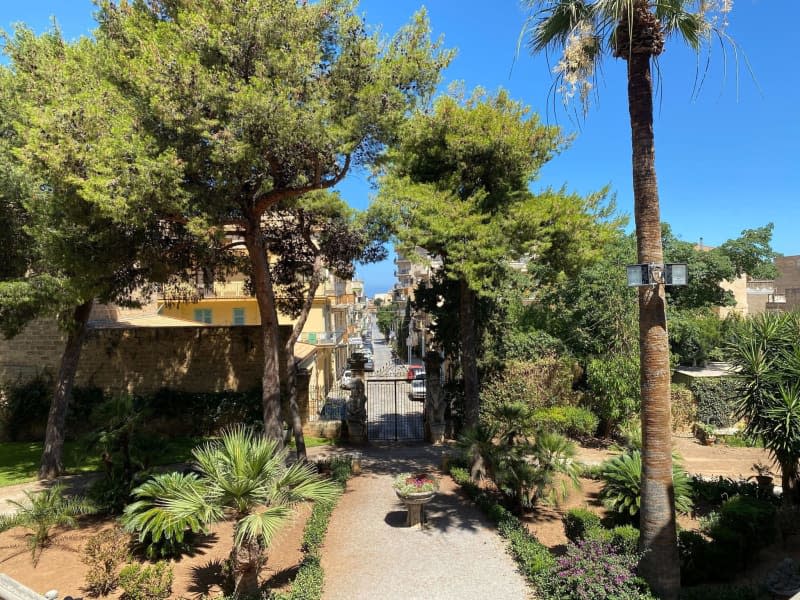Most tourists come to Italy for the wine and vistas, not to mention the pasta and pizza.
Many steer clear of the Triangle of Death – an area near the Sicilian capital Palermo that also includes the town of Bagheria.
The name dates back to the 1980s, when the Mafia carried out a series of gruesome killings in Bagheria and nearby Casteldaccia and Altavilla Milicia in the north of the island.
Bagheria, a town of some 50,000, remains a stronghold of the Sicilian Mafia, known locally as Cosa Nostra, to this day.
In the past, the town made headlines when Mafiosi brutally tortured and killed their victims in a remote, abandoned nail factory then dissolved the bodies in hydrochloric acid.
Today, the Mafia is more discreet. But while there is less bloodshed, they retain their steel grip on the region.
“Bagheria is still a Mafia town,” says an activist from the Pio La Torre anti-Mafia centre in Palermo.
The group’s grim legacy remains highly visible, with buildings disfiguring the skyline from a period of Mafia property speculation.
“From the mountains to the sea, the city is covered in concrete,” the activist says.
Many businesses still pay the “pizzo,” protection money extorted by the Mafia, he says.
The group also maintains a tight grip on Bagheria’s drug trade, and the town is struggling with a high unemployment rate.
Persistent Mafia presence
These influences mar what otherwise is a highly appealing town.
Bagheria, located just 15 minutes from Palermo, boasts a gorgeous coastline, breathtaking heritage and local cuisine shaped by the shoreline.
But Bagheria’s development has been paralyzed by the Mafia.
Despite the city’s attempts to curb its influence, calling on people to refuse to pay the pizzo and report those requesting it, or confiscating Mafia-owned properties, it remains almost impossible to remove the deep roots of the organization, the activist says.
The Mafia simply feels at home here, he says.
Once home to Sciliy’s nobility
Bagheria was founded as a place for the Sicilian nobility from Palermo to spend their summer holidays in villas outside the city.
Aristocratic residences dating back to the 17th and 18th centuries, such as Villa Palagonia, Villa Trabia and Villa Valguarnera, where the Italian writer Dacia Maraini grew up, still recall those times.
Following World War II, the Mafia began to focus heavily on real estate speculation, hoping to make cash fast selling ugly concrete structures.
In central Bagheria, the result is baroque villas beside clunky residential units, the impressive Villa Palagonia surrounded by multi-storey buildings.
Maraini, a local who has since moved to Rome, remembers the vista from Villa Valguarnera, which had to make way for the concrete blocks. “This view is now hideously obscured by pointlessly erected houses and tenements, to which trees, parks, gardens and old buildings have fallen victim,” she says.
The beauty of her hometown has been systematically destroyed by the structural disfigurement, Maraini says.
An estimated 2 million illegal buildings have been erected in Sicily, a practice called “abusivismo edilizio” – abusive construction – in Italian.
For every 100 buildings in Sicily erected legally, some 48 have been built without a permit, statistics authority Istat said recently.
Modern-day criminals
The way the Mafia operates in Sicily and other areas of Italy has changed fundamentally since the 1990s, and the Cosa Nostra has lost much of its power, say experts.
As a result, it is now much more difficult to detect their activities. Instead of bloodshed, Mafia bigwigs now focus on financial crimes and infiltrating the economy.
In Bagheria, the Mafia was closely linked to local politics for decades and did business in the property and agricultural sectors. That has changed, says the activist from Pio La Torre.
“Today, the core of their business is drug trafficking and extortion, which they can carry out autonomously,” he says.
In large Italian cities, hundreds of thousands take to the streets every year to demonstrate against the Mafia. Elsewhere, anti-Mafia centres such as Pio La Torre and individuals try to fight the criminals by focussing on youth work, organizing demonstrations or refusing to pay the pizzo.
One of them, a businessman from Bagheria, recently found his car on fire in a car park.
For many, however, this battle has long ended in resignation.
A survey of Italian students commissioned by Pio La Torre revealed that only one in five believes that the Mafia can be defeated.









